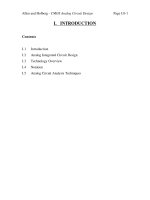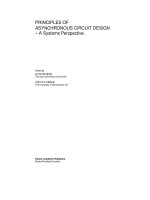Circuit design for linearizing transmitter
Bạn đang xem bản rút gọn của tài liệu. Xem và tải ngay bản đầy đủ của tài liệu tại đây (1.93 MB, 117 trang )
Circuit Design for Linearizing
Transmitter
Sim Chan Kuen
NATIONAL UNIVERSITY OF SINGAPORE
2003
Circuit Design for Linearizing
Transmitter
Sim Chan Kuen, (B. Eng., Nanyang Technological University)
DEPARTMENT OF ELECTRICAL ENGINEERING
A THESIS SUBMITTED
FOR THE DEGREE OF MASTER OF ENGINEERING
NATIONAL UNIVERSITY OF SINGAPORE
2003
i
Acknowledgement
I would like to take this opportunity to express my warmest thanks to many people
who have contributed towards the production of this thesis.
In particular, I thank my supervisors, Dr. Michael Chia Y. W. and Prof. Lye Kin Mun.
I thank Dr. Michael Chia for his guidance and support. He spent a tremendous amount
of time teaching me discussing the research problem and checking this thesis.
I thank my friends and colleagues in the Transceiver System group of Institute of
Infocomm Research (I2R). They advised me throughout the course of work and in
completion of this thesis.
Lastly, I thank my family for their constant support and care.
ii
Contents
Acknowledgement
i
Contents
ii
List of Figures
v
List of Tables
viii
Summary
ix
Chapter 1
Introduction
1
1.1
Background
1
1.2
Power Amplifier
3
1.3
Objective
5
1.4
Thesis Organization
5
Power Amplifier Characteristics and Linearization
7
2.1
Classification of Power amplifier
7
2.2
Distortions of Power Amplifier
9
2.3
Modeling of Power Amplifier
13
2.4
Power Amplifier Testing
14
2.4.1
Two Tones Test
14
2.4.2
Noise-Power-Ratio (NPR)
15
2.4.3
Adjacent Channel Power Rejection (ACPR)
15
2.4.4
Emission Mask
16
Chapter 2
2.5
Linearization
17
2.5.1
Cartesian Feedback
17
2.5.2
Feedforward
19
iii
Chapter 3
2.5.3
Envelope Elimination and Restoration
21
2.5.4
Linear Amplification with Non-Linear Components
22
2.5.5
Predistortion
24
The Design of Analog Predistorter
27
3.1
Introduction
28
3.2
System block of the analog predistorter
32
3.3
System Consideration
35
3.4
Circuit Implementation
39
3.4.1
Analog Multiplier
39
3.4.1.1 Brief Survey
39
3.4.1.2 Implementation of Analog Multiplier
43
3.4.2
Transconductance cell
50
3.4.3
Transimpedance cell and Output Buffer
52
3.5
Simulation
54
3.6
Layout
56
3.7
Completed Chip
59
Tests Results for the Analog Predistorter
60
4.1
Predistorter Performance
61
4.2
Low-IF Analog predistortion
62
4.2.1
Two-Tone Tests
62
4.2.2
Multi-carrier signals
68
4.2.3
OFDM signals
70
4.2.4
IS95
73
Chapter 4
4.3
Baseband analog predistortion
75
iv
4.4
Chapter 5
Analog predistortion for Radio Over Fiber System (ROF)
80
Conclusions
87
Bibliography
90
Appendix
95
v
List of Figures
1.1
Modern Transmitter Architecture
2
2.1
Basic Circuit Diagram for Power Amplifier
8
2.2
Power Amplifier characteristics
11
2.3
Intermodulation Distortion of Power Amplifier
11
2.4
Noise Power Ratio Testing
15
2.5
ACPR
15
2.6
Emission Mask
16
2.7
Cartesian Feedback
18
2.8
Feedforward Linearization
19
2.9
Envelope Elimination and Restoration
21
2.10
Linear Amplification with Non-Linear Components
22
2.11
Basic principle of Predistortion
24
3.1
Implementation of Predistorter at different stage of the Transmitter
31
3.2
Block of the 3rd Order Analog Predistorter
35
3.3
A Basic Bipolar implementation of Analog Mulitplier
40
3.4
Two general method of implementing analog multiplier in CMOS
41
3.5
Analog Multiplier
44
3.6
The complete analog multiplier
47
3.7
Simulated Result of the multiplier
48
3.8
Simulated distortions in multiplier
49
3.9
Transconductance cell
51
3.10
Simulated results of the transconductance cell
52
3.11
Transimpedance cell
53
vi
3.12
Output Buffer
54
3.13
Die photo of the predistorter
59
4.1
Pout vs Pin of the power amplifier
62
4.2
A Two Tone Test performed on the power amplifier
63
4.3
Test setup for low-IF predistorter
64
4.4
Before Linearization (Two-tones test at low-IF)
65
4.5
After Linearization (Two-tones test at low-IF)
65
4.6
A two-tones test with varying input power
66
4.7
Multi-Carrier Test(Before Linearization)
68
4.8
Multi-Carrier Test(After Linearization)
69
4.9
Frequency spectrum at the input of the power amplifier
(Before Linearization)
4.10
Frequency spectrum at the ouptut of the power amplifier
(Before Linearization)
4.11
71
Frequency spectrum at the input of the power amplifier
(After Linearization)
4.12
71
72
Frequency spectrum at the output of the power amplifier
(After Linearization)
72
4.13
IS95 signals (Before Linearization)
74
4.14
IS95 signals (After Linearization)
74
4.15
Test setup of baseband predistortion
76
4.16
Overall output spectrum for baseband predistortion
two-tones test (before linearization)
4.17
77
Zooming on the frequency spectrum around the two tones
for baseband predistortion two-tones test (before linearization)
77
vii
4.18
Overall output spectrum for baseband predistortion two-tones
test (after linearization)
4.19
78
Zooming on the frequency spectrum around the two tones
for baseband predistortion two-tones test (after linearization)
78
4.20
Test Setup using predistorter in Radio Over Fiber system
80
4.21
Overall output spectrum for ROF predistortion two-tones
test (before linearization)
4.22
Zooming on the frequency spectrum around the two tones
for ROF predistortion two-tones test (before linearization)
4.23
81
Overall output spectrum for ROF predistortion two-tones
test (after linearization)
4.24
81
82
Zooming on the frequency spectrum around the two tones
for ROF predistortion two-tones test (after linearization)
82
4.25
Two-tones test for ROF system
83
4.26
Multi-Carrier Test for ROF system(Before Linearization)
85
4.27
Multi-Carrier Test for ROF system(After Linearization)
85
viii
List of Tables
4.1
Performance of Predistorter
61
4.1
Comparison of two-tone test results performed by different design
67
Chapter 1
Introduction
1.1 Background
The primary purpose of any wireless communication systems is to transmit or receive
information. The information could be in any form such as speech, pictures or data. In the
area of cellular and personal communication service (PCS) systems, there is a trend of
transmitting data and video instead of merely speech. In third generation (3G) cellular
systems, such as WCDMA system, the data rates that could be transmitted will enable
even video to be transmitted through cellular systems. With higher data rates of the 3G
systems, it will open up a whole range of services to the consumers.
One of the major enabling device for 3G or future cellular systems is the transceiver.
Page 2
It consists of the two major blocks, the receiver and transmitter. The receiver receives
information from air. Whereas the transmitter transmits information generated by the
cellular terminals to the air. It is thus front end of cellular communication systems.
I
DAC
Local
Oscillator
VGA
Antenna
900
Phase
Shifter
Q
RF Power
Amplifier
DAC
Figure 1.1
Modern Transmitter Architecture
The block diagram of the modern transmitter is shown in Fig 1.1 [1]. The I and Q
channels generated by the baseband is converted into analog signals by the Digital-toAnalog converters (DAC). It will then be low pass filtered and upconverted by the mixers
to radio frequencies. The signals are amplified by the variable gain amplifiers (VGA).
The final amplification of the signals is by the power amplifier. It will drive the antenna
and transmitted to the air.
Page 3
1.2 Power Amplifier
One of the major blocks of the transmitter is the power amplifier [2]. This component
consumes the most power of the transceiver [3]. For example, RF MicroDevices’s
RF2161 [4] or Raytheon’s RTPA5250-130 [5] consume 0.4W and 0.66W respectively.
To achieve higher data rate and be spectrally efficient, communication systems use linear
modulation for example QAM (Quadrature Amplitude Modulation). Linear modulation
allows more data to be send within a given bandwidth. However, linear modulation will
have varying envelope at the output of the power amplifier. To properly amplify the
signal, the power amplifier must be linear. But linear power amplifier consumes a lot of
power compared to non-linear power amplifier.
A non-linear power amplifier will cause undesirable distortions to the transmitted signal.
This will lead to an increase in the overall error rate of the communications system. Not
only that, a non-linear power amplifier will exhibit spectral regrowth [1]. This will cause
distortions to adjacent channels.
It is possible to design a class A power amplifier to meet the linearity requirements for
modern communication systems. But class A power amplifier is highly inefficient in
power. Theoretically the efficiency of the class A amplifier is 50% [1]. But in actual
implementation, the efficiency of the power amplifier is much lower than 50%.
Page 4
Power efficiency of the power amplifier will affect the power consumption of the
transmitter. Being the most power consuming block of the transceiver, any reduction in
power consumption will reduce the power consumption of the whole transceiver system.
A reduction of power consumption will increase the talk time of the communication
equipment. This is especially important for cellular mobile phones.
Therefore there is a compromise between the efficiency and linearity of the power
amplifier. Generally, class AB power amplifier is good compromise between linearity
and efficiency.
Page 5
1.3 Objective
The objective of this research is to improve the linearity of the Radio Frequency (RF)
power amplifier so as to operate the power amplifier near the peak efficiency so as to
increase the talk time of the mobile handsets.
1.3 Thesis Organization
The thesis is organized as follows:
In chapter 2, the general characteristic of the power amplifier is explained. It shows how
the power amplifier could be modeled, the distortions it creates and the different metrices
to measure the linearity of the power amplifier. In this chapter, the reader will also
acquaints himself the general techniques that are used to improve the linearity of the
power amplifier namely feedback, feedforward and predistortion.
The next chapter, chapter 3, the design of the new analog predistorter is described. This
shall include the architecture and circuit.
In chapter 4, the chip was used to linearise an actual RF power amplifier. The chip was
tested at IF and baseband. Two-tone test was used to test the improvement in the linearity
of the power amplifier. Then different linear modulations were injected into predistorter.
Page 6
The use of the predistorter was then extended to a Radio Over Fiber (ROF) system. The
result for the new usage of the predistorter was also illustrated.
Finally, chapter 5 presents a summary of the work done in linearization of the power
amplifier.
Chapter 2
Power Amplifier Characteristics
and Linearization
In this chapter, the different classes of power amplifier, the characteristics and the
distortions caused by the power amplifier would be briefly discussed. The modeling of
the power amplifier will also be covered. Some of the existing methods of linearizing the
power amplifier will be presented.
2.1 Classification of Power amplifier
There are different classes or types of power amplifiers namely Class A, B, C, E and F.
The above different classes could be grouped into two [3]. The first group, class A, B and
C, are power amplifiers that use the transistors as current sources. The second group,
class E and F, use transistors as switches.
Page 8
DC
RFC
Filtering/
Matching
Network
Vin
Figure 2.1
RL
Basic Circuit Diagram for Power Amplifier
Figure 2.1 shows the basic circuit diagram for all the power amplifiers [1]. The radio
frequency choke (RFC) feeds the DC power to the drain of the BJT. It is to provide low
impedance for the bias but high impedance for a.c. signals. The BJT could also be
replaced by other types of transistor e.g. NMOS. Filters and matching network are
connected at the output of the power amplifier. The filtering network is to reject all
undesired out of band signals. The matching network is required to deliver sufficient
power to the load, RL.
In the first group, class A, B and C, the transistors act as current sources. The transistor
will either sink or source current to the load. The differences between class A, B and C is
in their conduction angles. In class A, the power amplifier is biased such that the current
will conduct at all times. But the conduction angle is 180 degrees and below 180 degrees
Page 9
for class B and C power amplifiers respectively. The linearity for class A power
amplifiers is the best followed by B and C. But the power efficiency is the lowest for
class A and highest for class C. A compromise between linearity and power efficiency is
met by class AB power amplifiers.
Class E [6] and F power amplifiers are non-linear power amplifiers. The transistors in
Class E power amplifiers act as a switch rather than a current source. In an ideal switch,
when it is ON, the voltage across the switch is zero and the current will be the maximum.
When the switch is OFF, the voltage should rise to the maximum while the current is
zero. Therefore the ideal switching power amplifier has 100% efficiency. In Class F
amplifier, the filtering/matching network has resonances at one or more harmonic
frequencies including the fundamental carrier frequency. The filtering/matching network
will shape the output collector voltage of the power amplifier to a square wave like
waveform [7]. Generally, Class E and F power amplifiers are more efficient compared to
Class A to C power amplifiers. However, they generate more distortions than Class A to
C power amplifiers.
2.2 Distortions of Power Amplifier
Amplitude Distortion
Ideally the output of the power amplifier should follow the equation as shown in (2.1).
The output power, Pout, is K times of the input power, Pin. K is a fix constant.
Pout = K * Pin
--------- (2.1)
Page 10
Figure 2.2 compares the ideal response at the output of the power amplifier and the
practical amplifier. In pratice, there is a limited range where the power amplifier is able
to amplify the signal presented in the input. The value of the K, as in (2.1), changes as the
input of the power amplifier increases. When input power exceeds a certain level, the
power amplifier will be saturated. The non-linearity of the input and output of the power
amplifier is also termed as AM-AM conversion.
However, the efficiency near the
saturation point is the highest.
One of the ways to compare the linearity of different amplifiers is find the P1dB point.
This is the point where the output power of the actual power amplifier is 1dB below the
Output Power
ideal response of a power amplifier.
Ideal
P1db
Practical
Input Power
Figure 2.2 Power Amplifier characteristics
Page 11
The most serious consequence of the amplitude non-linearity is intermodulation
distortion. Figure 2.3 illustrates this distortion.
Amplitude
Amplitude
Power Amplifier
Frequency
Frequency
Figure 2.3 Intermodulation Distortion of Power Amplifier
Ideally when two frequency tones are injected into the power amplifier, the output of the
power amplifier will have exactly the same two frequency tones but with amplified
amplitude. Intermodulation distortion causes the power amplifier to produce extra
frequency components other than the two original frequency components. These
additional frequency components will increase in amplitude as the power amplifier is
approaching its saturation point and they cannot be filtered out because it is within the
bandwidth of the system. Due to intermodulation distortion, there is spectral regrowth at
the output of the power amplifier. This will cause interference of adjacent channels.
Page 12
Phase Distortion
The other subtle aspect of linear power amplifier is that it should have a linear phase
response [7]. It meant that the time delay between the input and output of the power
amplifier should be the same across its bandwidth. If the time delay is different the output
of power amplifier will be distorted.
One of the phase distortion caused by the power amplifier is known as AM-PM
conversion [7][8]. It happens when the input modulated signal caused a phase change in
the output of the power amplifier. The modulated signal will cause extra frequency
components at the output of the power amplifier.
The distortions discussed above do not take into account of the memory effects of the
power amplifier [9][10]. For a memoryless power amplifier, it has the same level of
distortions throughout its bandwidth. But the actual power amplifier will have different
AM-AM and AM-PM distortions at different parts of its bandwidth. Generally, using the
assumption of memoryless power amplifier, it is possible to model the typical distortions
in the power amplifier.
Page 13
2.3 Modeling of Power Amplifier
The simplest way to model the power amplifier is by using a power series [11] as shown
in (2.2).
Vo = a1Vi (t ) + a3Vi 3 (t ) + a5Vi 5 (t ) + ........ .
--------(2.2)
Vo (t ) and Vi (t ) are the output and input of the power amplifier respectively. an are the
complex coefficients of the power amplifier. These coefficients give you the gain of the
various frequency components. It is assumed that the power amplifier has a narrow
bandwidth compared to the RF frequency that it is being transmitted. Therefore even
order frequency components do not fall into the bandwidth of the transmitter and could
be filtered out. Using the power series, it is able to model the 1db compression point, gain
and phase distortion. But the distortion caused by the higher order in the power series is
very low. The most serious distortion is caused by third and maybe the fifth order in the
power series. Therefore most power amplifier could be modeled adequately by a fifth
order power series.
There are other models available such as [12]. The common methods in power amplifier
modeling are given in [7]. But these models tend to be more complex than the power
series and no comparisons of accuracy of different models are given.
Page 14
2.4 Power Amplifier Testing
In order ascertain the linearity of the power amplifier, it should be measured using two
tones test, noise power ratio, adjacent channel power rejection and emission mask. These
tests give an indication of the non-linearity in power amplifier and could be adapted to
test the linearity of wideband signal (i.e. WCDMA) and multi-carrier system (i.e.
OFDM).
2.4.1 Two Tones Test
The two-tone test is the standard test for linearity of the power amplifier. Figure 2.6
shows how the two-tone test is performed. It is to input two frequency tones to the power
amplifier. For a narrow band system, the frequency spacing of the two tones is estimated
to be the bandwidth of the transmitter. At the output of the power amplifier, other
frequency components, caused by the intermodulation distortion, will be measured by a
spectrum analyzer. As the input power to the power amplifier is increased, the extra
frequency components will also increase, normally at a faster rate than fundamental two
tones. Third order intermodulation distortion (IMD3) is the most serious distortion.
The two-tones test is the simplest test to be performed on the power amplifier. Also it
qualitative of the improvement in linearity before and after linearization is implemented.
Page 15
2.4.2 Noise-Power-Ratio (NPR)
Amplitude
Amplitude
Power Amplifier
Frequency
Frequency
Figure 2.4
Noise Power Ratio Test
Noise Power Ratio Test [7] is normally used to test the linearity of multi-carriers
communication systems. The center channel is switched off. Non-linearity in the power
amplifier will produce distortions hence will fill up the center channel. By observing the
level of increase at the center channel, it is possible to measure the distortions introduce
by the power amplifier.
2.4.3 Adjacent Channel Power Rejection (ACPR)
Amplitude
B1
B2
Frequency
Figure 2.5 ACPR









